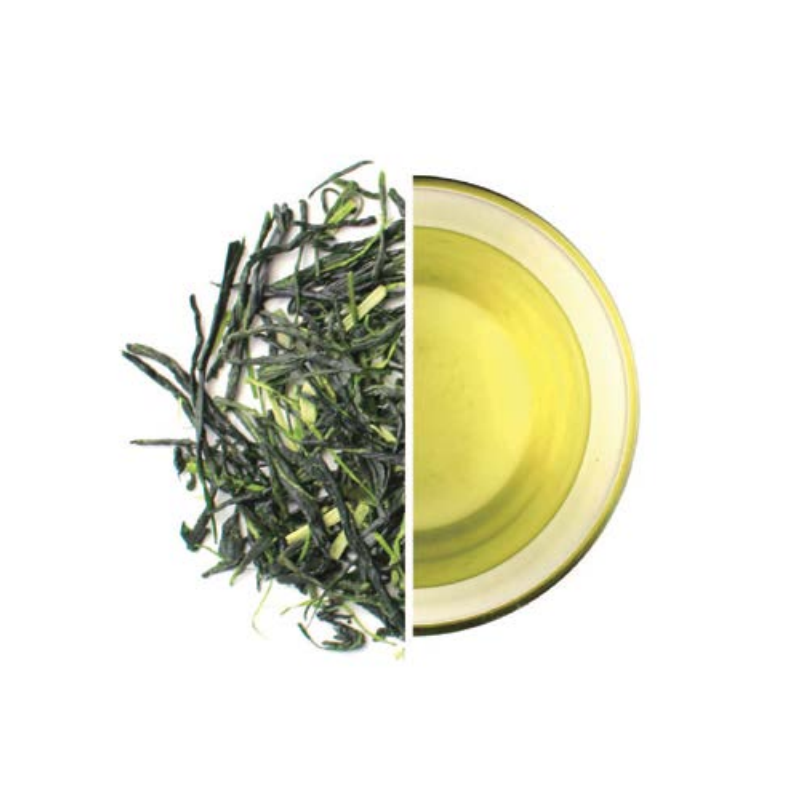Description
What is Gyokuro?
Gyokuro (玉露) – the highest grade Japanese loose leaf Gyokurotea – is as unique as its name – ‘dew drop’.
In contrast to making shaded Sencha, where the covers for blocking direct sunshine are spread directly on the plant,
Gyokuro is grown under a special construction that allows more space for the tea leaves to steep out.
The tea plant is shaded for about three weeks, during which fresh spring tea leaves develop a distinctive rich flavor and sweet smell.
After the harvest the leaves are processed with great care, the result of which an emerald-green tea of unique beauty.
Due to the level of care and attention needed to produce Gyokuro it is a rather rare tea – less than 1 percent of all tea made in Japan is Gyokuro.
Brewed tea, that gives off a distinctive fragrance, is traditionally served in little cups which makes enjoying Gyokuro even more special.
In contrast to making shaded Sencha, where the covers for blocking direct sunshine are spread directly on the plant,
Gyokuro is grown under a special construction that allows more space for the tea leaves to steep out.
The tea plant is shaded for about three weeks, during which fresh spring tea leaves develop a distinctive rich flavor and sweet smell.
After the harvest the leaves are processed with great care, the result of which an emerald-green tea of unique beauty.
Due to the level of care and attention needed to produce Gyokuro it is a rather rare tea – less than 1 percent of all tea made in Japan is Gyokuro.
Brewed tea, that gives off a distinctive fragrance, is traditionally served in little cups which makes enjoying Gyokuro even more special.
Characteristics
Taste
Silky, sweet, smooth and rich Umami
Silky, sweet, smooth and rich Umami
Color:
Leaves: Dark green
Tea: Pale green
Aroma
Hints of caramel and a lingering melon
The leaves
The leaves:
Example–dark green and sharp needle
The tea is made up of only soft sprouts, so it is fine and tight. The soft tips of the sprouts are powdery, and the flavor is especially concentrated in those areas.
Example–dark green and sharp needle
The tea is made up of only soft sprouts, so it is fine and tight. The soft tips of the sprouts are powdery, and the flavor is especially concentrated in those areas.
The used tea leaves:
The used tea leaves are thin, wide and bright green like boiled spinach.
You can eat it as “Ohitashi” only by pouring soy sauce on it.
Recipe for used tea leaves
Origin
Origin: Wazuka (Kyoto)
Farmer: Akihiro Kita
Tea field:
(example)Kabukese-tea garden at a high altitude with good sunshine.
The tea plantation has a good view of the steep southeast-facing slope at an altitude of over 500 meters.
In early May, as soon as the shoots sprout, they are covered with a black cover to shade them from the light,
and the tea is grown for two weeks or more before being harvested in mid-May.
Tea cultivar: Gokou (35-year-old)
Cultivation: Shaded 21 days
Harvest season: Early May
Processing: Lightly steamed (20 sec.), rolled, dried
Second processing: None
Farmer: Akihiro Kita
Tea field:
(example)Kabukese-tea garden at a high altitude with good sunshine.
The tea plantation has a good view of the steep southeast-facing slope at an altitude of over 500 meters.
In early May, as soon as the shoots sprout, they are covered with a black cover to shade them from the light,
and the tea is grown for two weeks or more before being harvested in mid-May.
Tea cultivar: Gokou (35-year-old)
Cultivation: Shaded 21 days
Harvest season: Early May
Processing: Lightly steamed (20 sec.), rolled, dried
Second processing: None


Hana –
Fantastic! Its what I have drunk in Japan! Recommended!
Tuan P. –
Very good tea. I love the aroma and the taste. Totally recommended!
Henrik –
Denne teen er super!